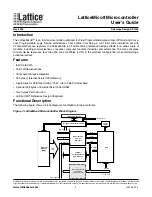
TC1796
System Units (Vol. 1 of 2)
Clock System and Control
User’s Manual
3-5
V2.0, 2007-07
Clock, V2.0
Figure 3-3
Main Oscillator Circuitry
3.2.1.1
Oscillator Bypass Mode
Especially for test purposes, the oscillator circuitry can be bypassed (disabled). In this
oscillator bypass mode, the clock line
f
OSC
is disconnected from the oscillator circuitry
and directly connected to the XTAL1 pin. The oscillator bypass mode is controlled by bit
OSC_CON.MOSC.
•
Normal Mode
(OSC_CON.MOSC = 0):
f
OSC
is derived from the crystal or from an external clock signal
•
Oscillator Bypass Mode
(OSC_CON.MOSC = 1):
The oscillator is bypassed and
f
OSC
is directly derived from an external clock signal
which is applied to XTAL1.
The MOSC bit can be set in two ways:
•
By software: Writing a 1 to bit MOSC of register OSC_CON.
•
By hardware at a power-on reset operation: If pin BYPASS = 1, the state of the pin
P5.3/TXD1A is latched with the rising edge of PORST and determines the inverted
state of the MOSC bit. If P5.3 = 0 at the rising edge of PORST, MOSC is set and the
oscillator bypass mode is enabled (see also
MCS05601
TC1796
Oscillator
V
DDOSC
V
SSOSC
C
X1
4 - 25
MHz
C
X2
XTAL1
XTAL2
TC1796
Oscillator
V
DDOSC
V
SSOSC
XTAL1
XTAL2
External Clock
Signal
f
OSC
f
OSC
Fundamental
Mode Crystal
4
1)
- 40
MHz
1) in case of PLL bypass 0 MHz
V
DDOSC3
V
DDOSC3
Crystal Frequency
C
X1
,
C
X2
1)
4 MHz
8 MHz
12 MHz
16 - 25 MHz
10 pF
12 pF
18 pF
33 pF
1) Note that these are evaluation start values!
R
X2
1)
0
0
0
0
R
X2
R
Q















































